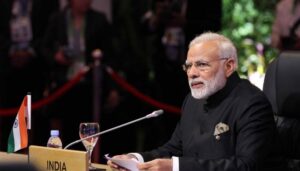
The BJP government’s large-scale health insurance initiative was rolled out in some states today, to coincide with Independence Day celebrations across the country.
Though some anticipated a full-scale launch of the programme, the scheme was not launched nationwide but began a gradual rollout in select states. Full rollout of the scheme is expected on September 25th as announced by Prime Minister Modi in his Independence Day address.
“The healthcare initiatives of the government will have a positive impact on 50 crore Indians,” the Prime Minister said. “It is essential to ensure that we free the poor of India from the clutches of poverty due to which they cannot afford healthcare.”
As the highly anticipated scheme begins life, it is worth examining what Modicare is, who it’s for, how it is funded and what it means for the public health system in India going forward.

What is ‘Modicare’?
The National Health Protection Scheme (NHPS) – also known as Ayushman Bharat, Pradhan Mantri Jan Arogya Abhiyaan, or ‘Modicare’ – was announced in February this year by Union Minister for Finance Arun Jaitley in the 2018 Budget. The initiative represented, as Health Issues India wrote at the time, “the Modi government’s biggest commitment to healthcare to date.”
The particulars of the scheme are that it aims to provide free health insurance coverage worth RS 5 lakh to 10 crore economically vulnerable families. The scheme is projected to reach around 50 crore people, representing 41 percent of the country’s population.
Under the initiative, beneficiaries will be able to avail healthcare for free in empanelled government and private hospitals. 1,354 treatment packages are covered under Modicare, including neurosurgery, neonatal care and stenting. Prices of the treatments under Modicare are anticipated to be between fifteen and twenty percent cheaper than standard rates for similar procedures.
The scheme is Aadhaar-linked. Patients can check their eligibility on the scheme’s website.
Who pays for it?
The announcement of the scheme came with an allocation of Rs 10,000 crore (1.4 billion USD). This has led to its being dubbed the world’s biggest government-funded healthcare scheme.
The scheme caused controversy shortly after its announcement, as many felt its financing model was unclear. The Centre stated that the Rs 10,000 crore allocation would be funded by a ‘health and education’ cess (hypothecated tax) of four percent on personal income and corporation tax.
The cost of the scheme was further expected to be split between the Centre and state governments, with forty percent of the cost expected to be borne by the states. This has since been updated. While the sixty-forty funding ratio will be in place for most states, some states, including Himachal Pradesh, Jammu and Kashmir, and Uttarakhand, will see as much as ninety percent of Modicare’s costs covered by the Centre.

Who’s participating?
Many states have been reluctant to adopt Modicare, particularly those with existing health coverage initiatives.
At present, almost half of states will not be participating in Modicare. In a high profile move, West Bengal became the first state to opt out of the scheme. Chief Minister Mamata Banerjee asked why the state should “waste its hard-earned resources” on the scheme and criticised the decision of the government. Several other states followed in West Bengal’s footsteps, particularly those which are not governed by the BJP.
Curiously, West Bengal later reversed course and decided to sign up to the scheme. It is, in fact, one of the six states where Modicare was expected to be rolled out today. The others are Andhra Pradesh, Chhattisgarh, Gujarat, Haryana, and Manipur.
As for the readiness of the other states expected to sign up to the scheme, some – such as Bihar and Uttar Pradesh – may not be ready to implement it for as many as six months.

Will Modicare work?
Modicare has faced obstacles from the beginning – few of which, if any, seem to have abated since the announcement. The initiative will have to overcome India’s inadequate public health infrastructure, one which disproportionately affects rural areas. Many fear that inadequate infrastructure will present an obstacle for uptake of the scheme by those it is intended to benefit.
Difficulties surrounding the financing of the scheme also continue. Some have queried whether the allocation for the scheme is enough to achieve its ends which, fundamentally, is moving India towards universal health coverage (UHC). Some have argued that the allocation per household is too little to provide quality healthcare.
Others have suggested that the amount earmarked per family – Rs 5 lakh – may drive insurance companies to up premiums. This would limit the scheme’s cost-effectiveness and potentially result in budget overruns as the scheme was expanded to include more states and, potentially, more families (plans have been proposed which would cover families above the poverty line in states where they have been eligible for health coverage schemes in the past).
Critics also point to the track record of existing and past schemes which seek or have sought to expand health coverage. They have noted that such schemes, both at the state and federal levels, did not drive down out-of-pocket health expenditures by patients by any significant margin.
Many schemes, such as the Rashtriya Swasthya Bima Yojana, faced many of the same issues skeptics think will afflict Modicare, from low enrolment of intended beneficiaries to inadequate insurance coverage. These issues ultimately limited those initiatives’ outreach, hampered their progress, and negated their benefits. Whether Modicare will experience the same fate remains to be seen.

